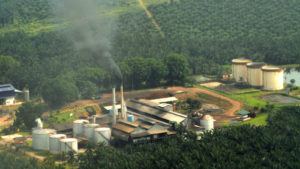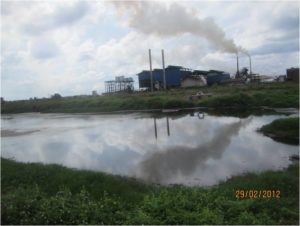Sime Darby Plantations – A New Model for Environmentally Friendly Palm Oil

Sime Darby Plantations, a Malaysian palm oil producer, is working hard to make palm oil more sustainable through the production of bioenergy.
The Palm Oil Industry and Its Challenge
Amidst rising incomes in the emerging markets and global population growth, the demand for palm oil is expected to triple by 2050, from 50 to 150 million tons per annum. Growing demand for palm oil is great for the emerging markets, particularly Malaysia and Indonesia, but could come at a significant environmental cost to the rest of the world.

Historically, the environmental worries over oil palm cultivation were limited to tropical deforestation, for both its release of large amounts of carbon dioxide emissions as well as for its impact on biodiversity. Today, stakeholders are turning to address a new worry – the release of large amounts of methane in the cultivation of oil palm. Methane leaks from palm oil from Malaysia and Indonesia alone, are estimated to be close to 10% of the amount of methane arising from global natural gas production and transportation.[1]
Up to this point, the environmental regulation of palm oil has been narrow in its focus, working only to ensure no further forests are felled. Without understanding the full scale of the industry’s environmental impact, only a handful of consumers had called for sustainability within the industry. Recently, CPG manufacturers have begun to demand that palm oil become more sustainable and that the industry drastically reduce its emissions. Palm oil players have had to take note given that most product formulations allow for uncomplicated substitution from palm to any of soybean, rapeseed or coconut oil. Stringent legislation affecting the importing of palm oil into the EU and the United States, is expected in the near-future.
Should the oil palm industry fail to drastically reduce their emissions and minimize its environmental impact, a significant loss of market share to other vegetable oils is to be expected. This will have devastating consequences to the livelihoods of the millions of farmers the industry employs and the economic development of Malaysia and Indonesia.
Sime Darby: A Model for Sustainable Palm Oil
Sime Darby Plantations (SDP), one of the world’s largest producers of palm oil, has for a long time been at the forefront of developing a more sustainable model for palm oil. Today, it is working to reduce its plantations’ emissions by 40% by 2020. To do this, it is now converting wastewater, an effluent of oil palm cultivation, and the source of methane emissions, into biogas, a source of bioenergy.

Across the industry, wastewater is typically channeled into manmade lagoons that are left to slowly evaporate. Thousands of these lagoons are spread across Malaysia and Indonesia, and the annual emissions of a large lagoon, can be equivalent to that of approximately 22,000 passenger cars.[2] The magnitude of such impact is driven by the potency of methane gas, which traps more than 25 times as much heat as carbon dioxide.[3] To deal with this, SDP has begun to capture and clean the methane from its lagoons, and convert it into biogas at biogas plants recently built near their plantations and mills. SDP have invested aggressively, and expect that 80% of its mills will have biogas capture by early 2017. Whilst some of this biogas is used to power their plantation’s operations, a lot of it is surplus, and for now is burnt via open flare, to produce carbon dioxide and prevent the direct release methane.

Whilst SDP has been quick to build out its biogas infrastructure it has yet to make significant headway into commercializing biogas in Malaysia. Working with the Malaysian government, SDP is planning to use biogas to generate electricity for rural communities. A lot will need to be done to commercialize biogas, further infrastructure will need to be built and tariffs will need to be agreed upon. The need to partner with the Malaysian government gives us the assurance that this will take time.
While waiting, SDP could consider converting its fleet of vehicles to run on BioCNG. Alternative fuel transportation projects in the United States (with landfill gas) have already proven the viability of BioCNG for vehicles.[4] Whilst this is expensive, between $6,000 – $12,000 per vehicle, the fuel savings alone should see SDP recoup its investment within 2 years.[5] This could serve as a proof of concept to convert Kuala Lumpur’s 37,000 taxis, which already run on compressed natural gas, to adopt BioCNG.
With less than 10% of the of the world’s palm oil mills operating with biogas capture, SDP is far ahead of its peers in providing sustainable palm oil.[6] SDP should look to market themselves as a partner in sustainability to CPG manufacturers. In doing so, they may be able to command a greater premium for their palm oil and ensure their continued export access to the United States and Europe.
(790 Words)
[1] http://ensia.com/voices/fixing-palm-oils-other-climate-threat
[2] http://www.nature.com/articles/nclimate2154.epdf
[3] http://www.simedarby.com/sustainability/case-studies/biogas
[4] http://www.afdc.energy.gov/fuels/natural_gas_renewable.html
[5] http://www.omafra.gov.on.ca/english/engineer/facts/12-043.htm
[6] http://www.climatecentral.org/news/a-renewable-solution-to-palm-oils-methane-problem-17208



Unbelievable! This is a fantastic example of how a HUGE problem (methane more harmful than CO2 and unavoidable biproduct of palm oil) can actually be a HUGE opportunity. If SDP finds a way to produce and sell BioCNG from its waste, it not only can create a new business to diversify its products but it can also create differentiation from other Palm Oil competitors. Perhaps SDP can create a higher barrier to entry for other palm oil producers by working with the government to make it mandatory to limit methane output? This would give SDP the opportunity to capture more Palm Oil market share while being a first mover in the BioCNG market.
Izkandar – Such an interesting article! Although not often discussed, this is clearly an important industry to target given that the demand for palm oil will triple by 2050. The business incentives are clearly aligned for palm oil producers to begin taking mitigation steps i.e. converting its fleet of vehicles to run on BioCNG and generating electricity for rural communities. Given the need to adapt, how can the Malaysian government partner with companies like SDP to enable faster implementation of the steps described? Further, with the increasing demand for palm oil, there will likely be an increase in the number of production facilities. What framework should be established so these facilities are designed with sustainability in mind first to avoid costly upgrades in the future?
I agree with Nick’s comment that this is a large potential opportunity for SDP. This is such a fascinating problem to solve with a multitude of concerns extending beyond just the environment and business performance – this is an industry that employs millions of farmers whose livelihoods depend on the palm oil market.
I’m interested to see how the commercialization of biogas plays out in Malaysia as a lot can be learned from the necessary partnerships and investments in infrastructure and technology to move toward “greener” energy in other parts of the world. However, given the nature of the markets that SDP competes in (such as palm oil), I wonder how sustainable or profitable these big investments will be for them (or their investors) in the long run. In other words, it’d be interesting to learn more about the unit economics of wasterwater to bioenergy conversation via the biogas plants.
Further, the post mentioned a low barrier to substitution to other vegetable oils. I wonder how palm oil compares to the others in terms of environmental footprint. Could we envision a world where the investments in the conversion technology over time would make palm oil potentially obsolete for certain applications?
This is a really interesting topic, Izkandar. An issue that seems to be at odds with the proliferation of palm oil in this area of the world is food security. Given the expected continued population growth in East Asia, is there an unresolvable conflict that will drive innovation in palm oil alternatives, for example this yeast that is being tested by researchers in Bath?
https://www.theguardian.com/sustainable-business/2015/feb/17/scientists-reveal-revolutionary-palm-oil-alternative-yeast
Izkandar – great example from home, and thoughtful arguments. Although this admittedly beyond the scope of your essay – given the very prominent role the 5-Year Plans play in Malaysian Economic Development, are there state-backed incentives that are currently doled out to engender this sort of behavior? If not, are there plans or avenues for it to be included in the 12th 5-Year Plan?